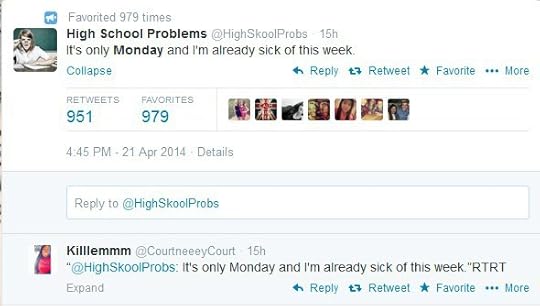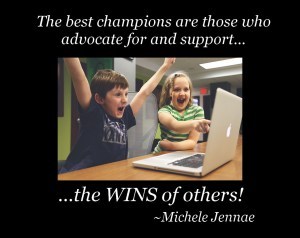Runa Heilung's Blog, page 16
September 14, 2015
The Trouble With Mondays
The trouble isn’t that there are 52 of them in a year.
(There are 53 Mondays if the year starts on a Monday in a non-leap year, or if either of the first two days lands on a Monday during a leap year.)
 The trouble with Mondays isn’t even with Mondays at all, no matter the number. The trouble with Mondays is our approach to them. Perhaps it’s because 7 of 10 workers are unhappy at work, not engaged.
The trouble with Mondays isn’t even with Mondays at all, no matter the number. The trouble with Mondays is our approach to them. Perhaps it’s because 7 of 10 workers are unhappy at work, not engaged.
In fact, many a Sunday evening has been ruined with Monday taking the blame. I’ve heard of people who started dreading Monday on Friday evening. How horrible!
The trouble with Mondays is mindset. Unfortunately, many people would agree with this quote by American comedian Steven Wright, as found on Goodreads.
“Monday is an awful way to spend 1/7 of your life.”
Actually, an awful way to spend Monday is in that frame of mind. It’s like running a 10k race and slugging through the first 2 kilometers. After all, Monday is 20% of your work week. And just as in a race, how you start could very well determine how you finish.
Here are a few tips for more Mindful Mondays.
Finish Friday well. Don’t leave unpleasant tasks for Monday if you don’t have to. Also, make a list of things you want to accomplish in the next week, with a strong task list for Monday. Make sure there are enjoyable duties on that task list too.
Enjoy your weekend , if you’re lucky enough to have them off. It is time to accomplish things at home, pamper yourself, enjoy time with friends and family, heck, even be a little lazy. Make sure you accomplish the things you want to get done, reasonably. Seeing that the weekend wasn’t a waste with regard to personal activities can help you approach Monday ready to tackle your professional activities.
Mentally prepare for Monday by making up your mind that you will start strong and in a good mood. A decision to approach the day better is all it takes. It’s up to you to follow through on that decision, even as you embark on that morning commute with a bunch of grumpy people lamenting the loss of their weekend.
Give yourself something to look forward to on Mondays. Schedule lunch with a friend, at work, or outside of work if you can manage it. Get a coffee treat on your way to work, only on Mondays. Make Monday nights take out night at home so you can relish your evening.
Don’t invite Murphy to your Monday. You know, the guy that says, if something can go wrong, it will. I was unaware that Murphy was qualified to make laws for you. Refuse to participate. No police officers here are waiting for you to follow Murphy’s Law.
Start strong. Get to work a little early, leaving earlier if you have to. Sit at your desk and envision a great day, a great week. Get started on a task that will give you an immediate feeling of accomplishment.
Mindset is EVERYTHING! Make your Monday’s the best first day of the week you have.
September 11, 2015
Five Influencers to Follow
The internet abounds with incredible influencers. My favorites are the ones you can have a conversation with. See my top five below!
1. Bob Burg – I do believe my first interaction with Bob Burg was through snail mail, although I may have tweeted him at the same time. The thing is not only did he respond to my tweets but he sent me back a card in the mail too. Bob Burg is the consummate networker, and well he should be. He is the author of Endless Referrals, what could be considered a textbook for networking. Another favorite book, The Go Giver, which Burg authored with John David Mann, puts Five Laws of Success into an easily understood parable format. It was Bob and The Go Giver that ultimately inspired my very own business parable, The Connectworker.
Follow Bob @BobBurg and find more information at www.burg.com
2. Ted Rubin – I still remember when Ted Rubin started tweeting about RonR, his personal trademark on Return on Relationship. His book by the same name (written with Kathryn Rose) was published in early 2013. Departing from the original business concern of Return on Investment (ROI), Ted argues that business will see a much larger return to their bottom line by focusing on relationships. Ted always responds on Facebook and Twitter too. I like to wish him a Happy Tednesday every once in a while on a Wednesday.
Follow Ted @TedRubin and find more information at www.tedrubin.com
3. Gary Loper – Gary is a master Tweeter and prolific in his tweets of positive, inspirational quotes. Having worked with Bob Burg in the past, there is no doubt that he too is a master networker. He has a Blog Talk Radio show called Building Better Relationships and frequently does teleseminars in addition to the private coaching he offers. He is very engaged on Twitter.
Follow Gary @GaryLoper and find more information at www.garyloper.com
4. Dave Kerpen – I am getting ready to launch a pilot coaching program fashioned after the principles showcased in The Connectworker, and Dave’s book Likeable Business is one of the books I chose (along with The Go Giver) to enhance the program. In his book, he talks about his social media experiences, mentioning that he does whatever possible to reply to all tweets and mentions. His book is amazing, and Dave proves to be the epitome of what he teaches.
Follow Dave @DaveKerpen and find more information at www.davekerpen.com
5. Joel Boggess and Pei Kang – These powerhouses (husband and wife team) in the business coaching and podcast world are genuine connectors with whom I have had some lovely conversations. Their ReLaunch Show (listen from their website, iTunes, or Stitcher) delivers daily inspiration and motivation from powerhouse guests who share nuggets of gold that can help you with your own successful Launch or ReLaunch.
Follow Joel @JoelBoggess and Pei @DrPeiKang and their @ReLaunchShow and find more information at www.relaunchshow.com
September 10, 2015
Championing the Champion
/ˈCHampēən/
Noun
A person who has defeated or surpassed all rivals in a competition, esp. in sports
Verb
Support the cause of; defend.
Synonyms
champ – advocate – supporter – fighter
defend – advocate – uphold – protect – assert
Did you realize that champion is also a verb? Most of the time, we think of a champion in the substantive (noun). We think most often of the sports hero. Even the Merriam Webster definition above states that. We think of Rocky Balboa (fictional) as a “champion”, for example. The lyrics to the popular Queen song, “We Are The Champions,” even have a fighting reference.
It is true that many of our sports heroes are inspiring and many of them also support and defend other people and other causes, but they are almost always referred to as champions when referring to their accomplishments. Then there are those who champion (verb) other people and worthy causes. It is great that they are also recognized for their noble efforts and dedication.
But what about the everyday champions in your life? What about your personal champions? By that I mean those who not only set an example of how to live an extraordinary life, but actively encourage you to do the same. They champion you!!!
Those are the champions that I want to recognize. I hope that you will too. Let someone know how much you appreciate the fact that they are a champion to you and for you. (Share this article with them!)
I hope that you, too, in your pursuit of an elevated life this year, will strive to be a champion, in noun and verb.
Who are your champions? Tell us!!
September 9, 2015
From The Other Side of the Interview
 Interviews can be intimidating, especially panel interviews. Adequate preparation can make an interview feel more like a conversation, and less like an interrogation. Isn’t a little homework worth it for a potential five or six figures a year?
Interviews can be intimidating, especially panel interviews. Adequate preparation can make an interview feel more like a conversation, and less like an interrogation. Isn’t a little homework worth it for a potential five or six figures a year?
A networking colleague, Lisa Hatfield, recently messaged me about an occurrence regarding some interviews being held to source new candidates for the government services agency where she works. For the first time, she was not the interviewee, but one of the interviewers.
She says, “After conducting 2 interviews today and scoring them, it is interesting being on the other side of the table. This is also a lesson for me when I’m being interviewed.”
She recommends showing up early for an interview. At the state agency she works for, the candidate is given time prior to the interview to review the questions prior to the actual interview, so they have time to write down answers, consider their own questions, and analyze their responses.
Not every company gives you this valuable time to prepare the answers to your questions, so doing it on your own ahead of time is important. Also, being late is a big ugly mark against you that is difficult to overcome even with a stellar interview and show of qualifications.
She has these suggestions for the interview process.
1. Give detailed answers. It is painfully obvious when someone on the interview panel has to add questions to draw out the answer.
2. Think before speaking so you remain on topic.
3. Make sure your answer relates to the topic.
4. Provide detailed examples of an experience in the work environment.
5. Study the job description.
These suggestions sound like common sense, but a nervous applicant is apt to fumble a bit, especially when unprepared.
She adds the following faux pas that she noticed with some candidates.
One girl brought in a drink. The other just didn’t know how to be detailed enough. Are they experienced for the job? Yes, but based on answers and how we had to score, they won’t get the job.
My colleague’s point is that she has seen things from the other side of the table that she might not have thought of when she was the one interviewing. Her goal is to help you prepare more for your interviews so that you increase your chances of success.
Take away points:
Qualifications aren’t everything.
Preparation counts!
 In addition to her work for the government, Lisa Hatfield is a published author and maintains a blog to spotlight independent artists and the organizations they support. You can find out more at passionateorganizations.blogspot.com.
In addition to her work for the government, Lisa Hatfield is a published author and maintains a blog to spotlight independent artists and the organizations they support. You can find out more at passionateorganizations.blogspot.com.
Five Questions To Ask Yourself When Stuck In Your Job Search
The role of a good coach (career coach, life coach, business coach, etc.) is to ask great questions that help you to find the answers to determine your path. Here are five great questions to help you coach yourself in your career path.
1. Am I looking in the right places?
The path of least resistance is to fill out applications online, using hot job boards like indeed.com, careerbuilder and monster, but the hidden job market is full of opportunities not seen by the typical applicant.
Consider looking at the online career section of a company that you have an extreme interest in working for, based on industry, company culture, location, etc.
Consider looking in another industry if the one you are in is stagnant or on the decline. Your skills are very likely transferable, and a carefully crafted resume can help you make an industry transition. A good career coach can help you think of ways to apply your skills to a new line of work.
2. Am I top of mind?
It is important to be top of mind in your network for it to be effective for you. Regarding your network, your influenSPHERE is the core where you stand to gain the most in terms of your career goals.
Who works in the industry that you hope to find work in? Who is a center of influence in a complimentary industry that would gladly speak to your strengths in the workplace. These are the people that it pays to be top of mind with. Follow up with them as your goals change, but also find ways to help them personally and professionally. Follow the golden rule by helping them first. They are them more likely to think of you if an idea comes up regarding your professional advancement.
3. Am I memorable?
As far as the submission process goes, to be top-of-mind memorable is a challenging task to say the least, but it can be done. Having a carefully crafted cover letter and resume is essential. That means doing your homework.
One resume does not fit all, and templates for cover letters can get us in a boring rut that can do nothing for standing out. Research the company that you hope to work for. Speak their language by tailoring your cover letter and resume submission. It is worth a few extra hours of work instead of submitting a standard resume immediately. Also important are subject lines that stand out so the reviewer is more likely to open your mail.
Resume and cover letters do not come easily for most people. It is a specialized skill, much like marketing. Consider getting professional help if you are not getting the results you want.
4. Am I casting a wide net?
The job market is competitive. Even in the hidden job market, competition can be fierce. That means you must be flexible in your search. Relying on one or two submissions to get you employed is rarely enough.
Using multiple strategies can increase your chances for finding employment. Some of those strategies include online job boards, hidden job market sourcing via your network, using placement agencies, attending job fairs, and even accepting freelance opportunities in the interim.
5. Am I being proactive?
One of the problems with the open job market is that it is often very difficult to be seen as human. Your resume is often a digital part of the process and you may never know if another human actually views it, much less who that human might be if they do review it.
If your homework leads you to the name of the recruiter, hiring manager, or decision maker, take an opportunity to reach out in a more personal way. Send them a note in the mail, a carefully crafted email, or even a phone call. Often job searchers are told that it is not acceptable to go around the “accepted process” but with all the competition for jobs, proactivity can be an asset that plays nicely to your being memorable. After all, that and resourcefulness are certainly traits that could transfer well to the workplace.
September 8, 2015
Happiness is a Habit
You’ve probably rolled your eyes at a few uber-happy people. “It must be an act,” you tell yourself. “If they only knew my story, they’d understand why I’m such a grouch.”
It’s true. Happy is an attitude and attitude is a choice. In the book “The 100 Simple Secrets of Happy People” by David Niven, Ph.D., Secret #2 is “Use a strategy for happiness.” He proposes that both happy and unhappy people do things that create and reinforce their moods. It’s these very things that get us in deep ruts of unhappiness or what is seemingly a superhighway of good moods.
Many people develop the wrong habits because it gets them something they want, attention for example, even if it’s negative. A small child who won’t stop whining might even get a lollipop to get them to stop crying – a positive benefit that can reinforce a negative habit.
As an adult, you can choose to find positive benefits that reinforce your positive happy habits. From smiling at yourself in the mirror to wearing your favorite color, from reading positive quotes to counting your blessings, the possibilities are endless.
Like the book says, “know what you want, and use a strategy to get it.” Like two different routes that take you to the same place, using a positive strategy to get what you want will make for much better traveling.
Food for thought from Sonja Lyobomirsky, Ph.D., a Professor at the University of California, Riverside:
Happy people do not experience one success after another and unhappy people, one failure after another. Instead, surveys show that happy and unhappy people tend to have had very similar life experiences. The difference is that the average unhappy person spends more than twice as much time thinking about unpleasant events in their lives, while happy people tend to see and rely upon information that brightens their personal outlook.
What thought or memory helps you get your Happy Face on?
September 4, 2015
Are You Delivering All 3 Layers of a Customer Experience?
Experience Layered!
 If you’re in business, you’ve probably heard that your business will be more successful if you can provide an “experience” for your customer. What is often missed is that experience comes in layers.
If you’re in business, you’ve probably heard that your business will be more successful if you can provide an “experience” for your customer. What is often missed is that experience comes in layers.
OBSERVATION: According to etymonline.com experience originally was an “observation as the source of knowledge.” Seeing what you do, whether it be physically or with the mind (understanding) is important. This often takes repeated exposures to your message. This is how advertising tends to work, although interruptive marketing, where big $$ pays for prime time spots and multiple slots to get a message in front of you is passé. In the new world of relationships, you have to find a way to stay in front of your target market in a meaningful way so they think of you when they need what you offer.
VENTURE: You’ve got their attention. They take the plunge and give you a try. Experience also implies “knowledge gained by repeated trials.” Just what constitutes their knowledge of your product or service now? What did they feel? What problem did it solve? What benefit did it give them? Will they repeat it?
SHARE: Experience is also defined as the “state of having done something and gotten handy at it.” To get handy at something requires multiple times having done something. So now they have graced your establishment a few times. They are comfortable with your product or service. Hopefully, your story has become their story and now they share it with others.
Make sure you are thinking of these three stages of experience when you are drafting your marketing plan. Every step makes a difference. Get your customer to SEE, TRY, SHARE, and ultimately REPEAT!
What experiences have you had that you rave about?
September 3, 2015
FIVE Steps to Career Change Success
1. Determine that a career change is indeed the right choice for you
The job market is precarious, and transition is rarely ever easy. It is worth it to take the time to explore your reasons for wanting to make a move. Making that move for the wrong reasons often results in rash decisions that are not always easy to make a recovery from.
At the same time, it is foolish to think that a career change won’t be warranted for some reason in the future as the economy shifts. You may not have a choice, and it is better to be prepared.
2. Explore career options based on your current skills, ability, and interests
Often we find ourselves stuck in a career that has come as a result of our exceptional skills, for example an administrative assistant who has incredible organizational skills because of her work history, but actually has more of an affinity for management or sales.
The key is to frame the skills in a way that will complement a position in the new area of interest.
3. Network for career change success
The majority of jobs are found in the unlisted (underground) job market. Even jobs listed on popular job boards are often filled through word of mouth recommendations. Let your friends and associates know that you are looking, where appropriate. They might comment to a significant other, or one of their friends or associates, and come up with an open position that might be good for you. Use your online network too!
Extend your network by asking for informational interviews in the industry you are targeting. These interviews are for information gathering and relationship-building only. DO NOT ask for a job in these interviews. You can ask that they let you know of any ideas or thoughts they might have for you.
4. Define yourself to the market
In Guerilla Marketing for Job Hunters 3.0, the authors Jay Conrad Levinson and David E. Perry say that “personal branding is a matter of survival” and knowing how to market that brand is essential in the job hunt. Who are you in the market? What do you have to offer? How are you different from other candidates? All of this is your story, your brand!
Your resume isn’t the only thing that needs to stand out. How you conduct your search is important, and it may be more important than ever to have a portfolio of projects and experience to show both online and off.
5. Choose a career where you have passion
In the book The Power of Full Engagement by Jim Loehr and Tony Schwartz, it is said that “energy, not time, is the fundamental currency of high performance.” Doesn’t it make sense that you find more energy to do the things you love?
The book goes on to say that…
“less than 30% of American workers are fully engaged at work, according to the Gallup Organization in early 2001. Some 55% are “not engaged.” Another 19% are “actively disengaged,” meaning not just that they are unhappy at work, but that they regularly share those feelings with colleagues.”
It is probable that even if you aren’t in a career where you are passionate, that you have skills that are transferable to one where you are. If you are uncertain about that, or about how to make a career change, a career coach can help.
Coming Soon: Candidate Coaching Program – self paced. Are you “the candidate” for the job you seek, or “just another applicant”? Positioning is EVERYTHING! Call 916 538 0464 for more information.
August 18, 2015
What Does a Tire Company Have to Do With Top Rated Chefs?
What Does a Tire Company Have to Do With Top Rated Chefs? And how does that relate to our marketing efforts as business owners?
Did you know that the Michelin Star rating for top chefs was the evolution of a brilliant marketing piece published by André Michelin of – you guessed it – Michelin Tires?
In order to develop brand awareness for the tire company, André Michelin came up with the brilliant idea of creating and publishing a travel guide for French car owners. How else could a tire company stand out among tire companies?
A couple of other interesting tidbits about that Michelin Travel Guide
– The target market was very specific:Car owners in France to develop brand familiarity with Michelin Tires
– It was published for FREE as a value-add to car owners, only to be sold at a later date to re-instill the value once it was popular.
– The guide only later became a byproduct (profit center), but also became a symbol of highest quality in the restaurant world, while it reflected the same on the tire company itself.
– It was created in 1920, almost 100 years ago, before television and interruption marketing.
Takeaways:
1. Know your target market inside and out. What matters to them? How can you help them beyond your product?
2. Give away something that they can use, that they might otherwise pay for. Don’t worry about making it a profit center by-product, but focus on the value. If it happens later, great, but if not, your first goal is to build brand awareness and..
3. Build relationships with your audience. Social media engagement and email newsletters are great ways to do this.
Need help with your target market? Email me at [email protected]
August 11, 2015
Connecting People: Kayce Stevens Hughlett Author
This is part two of an extended interview with Kayce Stevens Hughlett, ideaphoric, published author, and life coach.
Michele Jennae: You’ve just finished your novel Blue and it’s currently in pre-release mode, and yet you are furiously busy with promotion. Thank you for taking the time to answer some questions about the book, and the process to promote and publish it.
Blue isn’t a very unusual word to use as the title of a book. What have you done to make sure your audience thinks of your book when they hear the word “blue”?
Kayce Stevens Hughlett: First of all, I love the idea of having a simple word with multiple meanings. It calls for use of imagination and all sort of ideaphoria. Second, I chose a really fantastic cover design (original artwork by Debbie Vinyard) with a lovable character on it, Sir Albert the Peacock. Then I started splashing BLUE all over social media and handing out bookmarks and sharing ‘blue’ associations. What’s happening is that when people see another peacock or something that is distinctly blue, like the July 31st Blue Moon, they think of the book. It’s been this wonderful explosion of blue everywhere.
MJ: In our ideaphoric mind interview we talked about the challenge of having oodles of ideas and keeping them organized. Blue is seemingly three separate ideas (or stories) that come together in an unexpected way. How did you write the book to keep your ideas straight?
Kayce: The original draft of BLUE actually wrote itself. The three main characters—Daisy, Monica, and Izabel—had distinct voices in what they needed to say. I held the undergirding story (i.e. how they were all related and what had happened to separate them) inside me; then I showed up at the page and let them have their say. “We” left hints for the reader along the way. When it came to the next few drafts, I kept notebooks and lists of important details to make sure everything lined up. For a few months I had post-it notes of the timeline plastered on my office wall to help keep it organized.
MJ: What has been your biggest challenge and your biggest reward so far with Blue?
Kayce: The biggest challenge was probably finding a publisher. I self-published my first book, As I Lay Pondering: daily invitations to live a transformed life, but BLUE wanted something different. I went the route of trying to find an agent, because the traditional publishing houses only accept books through an agent. It was an exhausting, frustrating, and unfulfilling process. I ultimately set the book aside and waited. One day a friend said, “Are you ready?” then introduced me to Shari Stauch at Where Writer’s Win who ultimately introduced me to BQB Publishing and a beautiful publishing match was made.
The biggest reward ties in with the challenge: Learning to relinquish control. When I turned my creation over to a third party, I realized this was not just mine anymore. The process has been both wonderful and challenging. In the past when I considered being out of control, it brought a groan to my body. Now, I’m practicing turning that groan into a glow as I trust that my publisher will take care of lots of details, thus freeing me to be more creative. The other out of control bonus (and scary/exhilarating part) is that BLUE seems to be taking its own flight and I am holding on for the ride.
MJ: Word has it that Amazon did a pre-release on your pre-release and over 100 books were shipped almost two months early. How did that affect your promotional process?
Kayce: This leads back to your last question regarding challenges and rewards. We originally thought it was only Amazon, but as it turns out books were also released to an independent distributor. No one is owning up to the “mistake,” but rumor has it that it was the power of the people who couldn’t wait for the book to be released. Serendipitously, the release actually happened on July 31, which was the full blue moon. Coincidence? Only the Universe knows.
As far as my promotional process goes, I freaked out over the out of control thing… and then I embraced it. I’m running a promotion for people who received “the books that wouldn’t wait.” There’s a contest with prizes and anyone who promotes their early release book is entered into the contest. I’m also inviting readers to post advance reviews on Amazon, Goodreads, Barnes & Noble, social media, etc. Trying to turn that groan into a glow!
MJ: Who should read Blue besides everybody?
Kayce: That about covers it. {smile} BLUE is a story about women, so naturally women will be more drawn to it. And male readers are finding it intriguing. It carries themes of family dynamics, psychological intrigue, and some pure fantasy fun and magic. There’s a little romance, some mystery, great clothes, beautiful settings, and a body-mind-soul theme that runs through it. I believe there truly is something for everyone!
MJ: What’s next on the horizon for the Kayce Stevens Hughlett, author?
Kayce: Right now, all I can see is BLUE. I do, however, have a travel memoir manuscript tucked in my drawer and look forward to diving into that this fall after I return from Paris where I’ll be leading a small group of ‘soulstrollers’ on their own life-transforming adventure.
One insecure perfectionist. One guilt-ridden artist. One child-woman who talks to peacocks. A trio of complex heroines on separate journeys toward a single intertwined truth.
Imagine living exclusively for others and waking up one day with a chance to start over. The terrifying new beginning reeks of abandonment and betrayal. The choice for Seattle resident Monica lingers between now and then . . . them and her.
Izabel’s idyllic existence on Orcas Island is turned upside down during the birth of a friend’s child. Suddenly, pain rips through her own body, and life as she knows it shifts, hinting at a forgotten past and propelling her toward an uncertain future.
On another island, young Daisy awakens surrounded by infinite shades of blue. Is she dreaming or has she stepped through the portal into a fantastical land where animals spout philosophy and a gruesome monster plots her destruction?
Blue-a subtle psychological mind-bender where each heroine is her own worst enemy. Eccentric. Loveable. Unforgettable.
Kayce Stevens Hughlett is an artist of being alive. Her passions include writing, speaking, lifestyle coaching, and taking groups for soul strolls in Paris. Her 2012 non-fiction book, As I Lay Pondering: daily invitations to live a transformed life is a lyrical and lucid treasure that invites readers to new awakenings throughout the year. It’s a perfect gift for yourself or others. Learn more about Kayce and her offerings at www.liveittogiveit.me.






